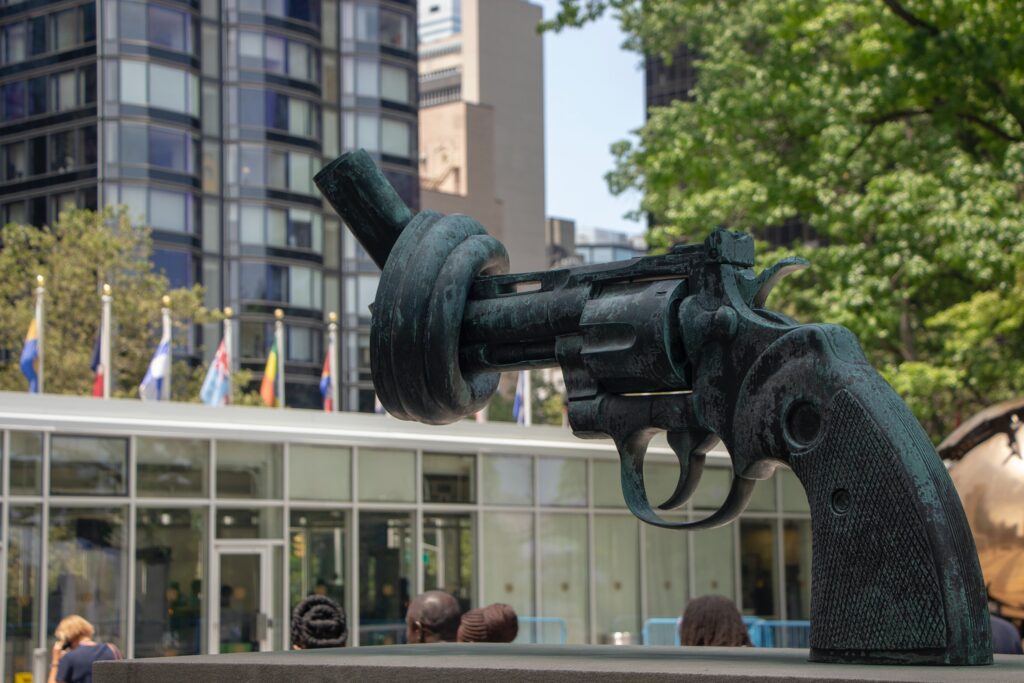Kaylee Tillett
Prior to 2008, gun-rights advocates referred to the Second Amendment as a “second-class right” with courts relying on a militia-centric interpretation articulated by the Supreme Court of the United States in United States v. Miller.[1] Nearly seventy years after Miller, the Supreme Court radically changed its interpretation of the Second Amendment in District of Columbia v. Heller.[2] In Heller, the right to keep and bear arms in one’s home for purposes of self-defense became the core of the Second Amendment, with the Supreme Court applying this right to the states two years later in McDonald v. City of Chicago.[3] Finally, last year, in New York State Rifle & Pistol Ass’n v. Bruen, the Supreme Court expanded the Second Amendment’s reach post-Heller and McDonald, holding “that the Second and Fourteenth Amendments protect an individual’s right to carry a handgun for self-defense outside the home.”[4]
Bruen significantly altered the landscape of the Second Amendment, not only by expanding the reach of the right to keep and bear arms beyond the home, but also by rejecting the legal standard previously used to decide Second Amendment cases.[5] Under Bruen, the new two-step analysis for Second Amendment cases begins with a presumption that if the plain text of the Second Amendment includes an individual’s conduct, then the Constitution protects that conduct.[6] Then, the government bears the burden of justifying its proposed regulation “by demonstrating that it is consistent with the Nation’s historical tradition of firearm regulation.”[7] When deciding Bruen, the Supreme Court focused its “historical analysis” on the firearm regulatory practices of the Founders in 1791 and the Reconstruction generation in 1868 because these are the relevant time periods when the Second and Fourteenth Amendments were written.[8] Specifically, the Supreme Court determined that the firearm regulations of the Twentieth Century put forth by the respondents were simply too recent to constitute a historical tradition and rejected this evidence, relying instead on the common understanding of firearms regulation at the time of the Founding and Reconstruction.[9]
One year post-Bruen, the landscape of the Second Amendment is primed for a novel legal issue that the Supreme Court evaded in Heller, McDonald, and Bruen, continuously passing the ball through dicta and concurrences—the right to keep and bear arms as applied to felons.[10] Born out of a series of high profile assassinations, the federal government’s regulation of a felon’s ability to possess firearms began as recently as the Gun Control Act of 1968, which was expanded by the Brady Handgun Violence Prevention Act of 1994, also known as the “Brady Bill.”[11] Today, a provision of the Brady Bill, 18 U.S.C. § 922(g)(1), makes it “unlawful for any person . . . who has been convicted in any court, of a crime punishable by imprisonment for a term exceeding one year . . . [to] possess in or affecting commerce, any firearm or ammunition.”[12] Federal courts are split on the validity of § 922(g)(1) after defendants began arguing that federal “felon-in-possession” laws violate the Second Amendment under Bruen.[13]
On June 6, 2023, the Third Circuit en banc determined that § 922(g)(1) violated the Second Amendment as applied to a non-violent offender.[14] Yet just four days prior, the Eighth Circuit ruled in the opposite, finding no constitutional violation.[15] Both Circuits relied on the two-step “historical foundations” analysis created in Bruen, yielding extensively disparate outcomes.[16] Prior to Bruen, in Heller, the Supreme Court explicitly included dicta deferring the analysis of whether the Second Amendment applied to felons.[17] In Bruen, the majority opinion did not address the issue at all.[18] In fact, the concurrences and the dissent in Bruen explain that the majority opinion need not include an analysis of federal “felon-in-possession” laws because they are “presumptively lawful.”[19]
On the contrary, government regulations prohibiting felons from possessing firearms are as recent as the historical evidence put forth by the respondents in Bruen, which the Supreme Court deemed too modern for “consisten[cy] with this Nation’s historical tradition of firearm regulation.”[20] As discussed above, the federal government only began regulating the firearm possession of felons in 1968—decades before the Reconstruction generation and more than a century after the Founding.[21] Further, the “historical tradition” that courts, such as the Eighth Circuit, are beginning to rely on to deny felons their Second Amendment rights is disturbing, including historical regulations that categorically exclude Black and Native Americans, as well as certain religious minorities, from possessing firearms.[22] Specifically, the Eighth Circuit recognized that regulations barring certain races from the right to keep and bear arms “would be impermissible today under other constitutional provisions,” yet included these regulations in its historical tradition analysis regardless.[23] Even the language of “law-abiding” citizen used throughout Bruen is ambiguous, as the sheer breadth and scope of what constitutes a “felony” has dramatically changed since the time of the Founding.[24]
As the number of Bruen challenges grow, it is time for the Supreme Court to define explicitly whether the Second Amendment extends to felons; however, this issue illuminates a Pandora’s box of sub-issues, including, but not limited to, (1) the differences between violent and non-violent felonies, (2) the disconnect between a state felony and a federal felony, (3) the length of time between the original felony conviction and the § 922(g)(1) charge, (4) the amount of time actually served in a jail or prison compared to a purely probationary sentence, and (5) the record of the particular felon.[25] The Supreme Court’s staunch devotion to originalism and the dead-hands of the Founders has brought the Supreme Court to a precipice.[26] Either the Second Amendment is an unmitigated right provided to all Americans based entirely on the historical traditions of the Nation, or it is not.
[1] United States v. Miller, 307 U.S. 174, 178 (1939).
[2] District of Columbia v. Heller, 554 U.S. 570, 577–78 (2008).
[3] Heller, 554 U.S. at 577–78; McDonald v. City of Chicago, 561 U.S. 742, 748 (2010).
[4] New York State Rifle & Pistol Ass’n, Inc. v. Bruen, 142 S. Ct. 2111, 2122 (2022) (emphasis added).
[5] Id. at 2125.
[6] Id. at 2129–30.
[7] Id. at 2129–30.
[8] Id. at 2132.
[9] Id. at 2138 (“[A]part from a handful of late-19th-century jurisdictions, the historical record compiled by respondents does not demonstrate a tradition of broadly prohibiting the public carry of commonly used firearms for self-defense.”).
[10] Range v. Att’y Gen. of the United States, 69 F.4th 96, 98 (3d Cir. 2023).
[11] Gun Control Act of 1968, Pub. L. No. 90-618, 82 Stat. 1213; Brady Handgun Violence Prevention Act, Pub. L. No. 103-159, 107 Stat. 1536 (later codified as amended at 18 U.S.C. § 922).
[12] The federal definition of a “felon” is broader than many state definitions, applying where the potential sentence is more than two years for misdemeanors and more than one year for felonies. 18 U.S.C. § 922(g)(1); 18 U.S.C. § 921(a)(20)(B).
[13] Albert W. Alschuler, Do Convicted Felons Have a Constitutional Right to Bear Arms?, Verdict Justia (June 21, 2023), https://verdict.justia.com/2023/06/21/do-convicted-felons-have-a-constitutional-right-to-bear-arms.
[14] Bryan Range pleaded guilty in 1995 to making a false statement to obtain food stamps, violating Pennsylvania law. Range, 69 F.4th at 98. Range was sentenced to three years’ probation, although his misdemeanor carried a maximum sentence of five years’ imprisonment. Id. Range sought to purchase a firearm for hunting and for self-defense in the home. Id.
[15] Edell Jackson had two convictions for sale of a controlled substance in the second degree from 2011 and 2012. United States v. Jackson, 69 F.4th 495, 501 (8th Cir. 2023). Jackson received a 78-month sentence for the first conviction and a 144-month sentence for the second conviction. Id. Interestingly, the Eighth Circuit cited approvingly the paneled Third Circuit’s previous decision in Range that the above-referenced en banc Third Circuit overruled. Id.
[16] Alschuler, supra note 13; see also Zak Goldstein, Federal Third Circuit Finds Felon in Possession of Firearm Laws Unconstitutional as Applied to Old, Non-Violent Offenses, Goldstein Mehta, LLC, Blog (June 7, 2023), https://goldsteinmehta.com/blog/federal-third-circuit-finds-felon-in-possession-of-firearm-laws-unconstitutional-as-applied-to-old-non-violent-offenses#.
[17] Heller, 554 U.S. at 626.
[18] Bruen, 142 S. Ct. at 2111.
[19] Id. at 2163.
[20] Michael Luo, Felons Finding It Easy to Regain Gun Rights, New York Times (Nov. 13, 2011), https://www.nytimes.com/2011/11/14/us/felons-finding-it-easy-to-regain-gun-rights.html; United States v. Bullock, No. 3:18-CR-165-CWR-FKB, 2023 WL 4232309 (S.D. Miss. June 28, 2023) (order dismissing case).
[21] Gun Control Act of 1968, Pub. L. No. 90-618, 82 Stat. 1213.
[22] Jackson, 69 F.4th at 501.
[23] Id.
[24] Alec C. Ewald, “Civil Death”: The Ideological Paradox of Criminal Disenfranchisement Law in the U.S., 2002 Wis. L. Rev. 1045, 1060 (2002).
[25] Bullock, 2023 WL 4232309, at *71–75; see also Brian Doherty, Another Judge Chips Away at Laws Barring Felons From Owning Guns, Reason (June 29, 2023, 11:15 AM), https://reason.com/2023/06/29/another-judge-chips-away-at-laws-barring-felons-from-owning-guns/.
[26] Bullock, 2023 WL 4232309, at *71–75.





